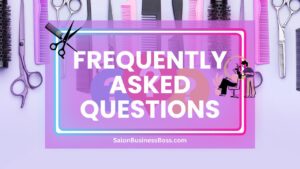In the dynamic world of salons, continuous skill development is key. Discover how salon owners can boost staff expertise through well-crafted training programs.
Salon owners can elevate staff skills with targeted training, fostering a culture of continuous learning. Tailored programs, covering trends and customer service, ensure professional growth and elevate overall salon performance.
1. Understanding Staff Needs: Recognizing and Bridging Skill Gaps

Running a salon is like orchestrating a symphony, and your staff is the talented ensemble. To make sure everyone is hitting the right notes, it’s crucial to recognize individual skill gaps. This isn’t about pointing fingers; it’s about understanding where each team member can fine-tune their performance.
Imagine your stylist who’s a wizard with scissors but a bit shaky on the latest color techniques. Instead of letting frustration brew, take a step back. Identify these gaps not as weaknesses but as opportunities for growth. Maybe they need more confidence in handling certain services or a better grasp of customer interactions.
Now, let’s not make this a guessing game. Regular check-ins, casual conversations, and even feedback sessions after each appointment can be your secret weapons. Create an open space where your team feels comfortable sharing their experiences and challenges. By doing so, you’re not just understanding their needs—you’re creating a culture that values growth.
Read more about: How to Succeed in Operating a Commission Hair Salon
2. Tailored Training Programs: Customizing for Salon Goals and Industry Trends
One-size-fits-all rarely fits anyone well. The same goes for training programs in a salon setting. Tailoring your training is like designing a bespoke suit—it fits perfectly, accentuating strengths and hiding flaws. In this case, the suit is your program, and your team members are the ones wearing it proudly.
Customization starts with aligning the content with your salon’s goals. If you aim to be the go-to place for cutting-edge styles, your training should reflect that. No need for an extensive color theory crash course if your brand screams simplicity and elegance.
But here’s the twist—while keeping your salon’s vibe intact, also tune in to the beats of the industry. Trends change faster than a hair flip, and your team needs to be in sync. Whether it’s the latest color craze or a revolutionary technique, weaving these into your training ensures your salon stays not just relevant but ahead of the game.
3. Hands-On Practical Sessions: Real-World Scenarios and Confidence Building
Ever tried learning to ride a bike from a manual? Doesn’t quite work, does it? Practical sessions are the training wheels for your team’s skills, letting them navigate the twists and turns of real-world scenarios.
Incorporate real-world situations into your training, giving your team a taste of what to expect. It’s not about throwing them into the deep end; it’s about creating a safe space to experiment and learn. Picture this: your stylist experimenting with a new color technique on a mannequin head before confidently offering it to clients. That’s the confidence boost practical sessions can provide.
Hands-on experiences aren’t just about perfecting techniques; they’re about building a resilient mindset. Mistakes happen, but it’s the learning that follows that shapes true expertise. Encourage your team to embrace challenges, learn from slip-ups, and celebrate victories, no matter how small.
4. Fostering a Culture of Learning: Nurturing Growth Through Continuous Improvement

Running a salon isn’t just about getting the hair right; it’s about fostering an atmosphere where everyone’s a student, learning and evolving with every snip and style. This isn’t a one-time lesson—it’s an ongoing class in the school of improvement.
Encouraging a mindset of continuous improvement isn’t about pointing out flaws; it’s about showcasing the beauty of growth. Imagine your stylist trying a new technique. Instead of saying, “This could be better,” you might say, “Great effort! How can we make it even more amazing next time?” It’s a subtle shift, but it transforms feedback into a compass, guiding your team toward excellence.
Continuous improvement is also about creating a playground for ideas. Encourage your team to share their thoughts, whether it’s about a trendy hairstyle they stumbled upon or a unique way to enhance customer experience. It’s these small sparks that can ignite innovation, pushing your salon to new heights.
Read more about: How to Succeed in Operating a Commission Hair Salon
5. Promoting Knowledge-Sharing Among Staff: Because Two Heads Are Better Than One
In a salon, knowledge isn’t meant to be hoarded—it’s meant to be shared, discussed, and celebrated. Promoting knowledge-sharing among staff is like creating a vibrant community where everyone contributes to the collective wisdom.
Picture this: your seasoned color specialist sharing a quick tip on perfecting a tricky shade with the newbie stylist. It’s not just guidance; it’s a passing of the torch. Encourage your team to share their experiences, whether it’s overcoming a styling challenge or discovering a product that works wonders. The more you foster this culture, the richer your salon’s collective knowledge becomes.
It’s not just about formal training sessions; it’s about those impromptu conversations at the styling stations, the quick exchanges in the break room, and the collaborative energy buzzing through your salon. This isn’t just about becoming better professionals; it’s about becoming a better salon family.
6. Measuring and Adapting: Steering the Ship with Feedback and Flexibility
Navigating the salon seas requires more than a map; it demands a constant eye on the compass. Measuring and adapting your training approach is like adjusting the sails, ensuring you catch the winds of progress and stay on course.
Implementing feedback mechanisms isn’t a one-way street; it’s a dialogue. Encourage your team to share their thoughts on the training sessions—what worked well, what didn’t, and what they’d love to explore further. Remember, feedback isn’t just about identifying problems; it’s about uncovering hidden potentials.
Now, let’s talk about performance evaluations. Instead of viewing them as judgment day, see them as a compass check. Are your stylists thriving in their newfound skills, or is there a need for a slight course correction? Maybe a particular training module resonated exceptionally well, while another needs a tweak. It’s this adaptability that ensures your training isn’t static but a living, breathing entity.
Summary
By investing in targeted training, salon owners set the stage for a dynamic journey. It’s not just about enhancing skills; it’s about fostering a culture where growth is the norm. Continuous improvement becomes the heartbeat, knowledge-sharing the melody, and feedback the guiding compass.
In this environment, your salon isn’t just a place to get a great haircut; it’s a community of learners, each contributing to the collective brilliance. It’s a dynamic, evolving space where every stylist isn’t just an employee but a valued participant in the journey of becoming the best version of themselves.
So, as you embark on this training adventure, remember, it’s not just about the scissors and colors; it’s about nurturing talent, sharing wisdom, and sailing towards success together. Here’s to a salon that doesn’t just make people look good but makes them feel a part of something extraordinary.
Frequently Asked Questions

1. How can salon owners identify the specific training needs of their staff?
Salon owners can assess individual skills, solicit feedback, and track performance to pinpoint areas for improvement, ensuring tailored and effective training programs.
2. What makes a training program in a salon effective?
Effective salon training involves customization to address current industry trends, hands-on practical sessions for skill reinforcement, and a continuous learning culture fostering staff confidence and expertise.
3. Why is measuring and adapting crucial in salon staff training?
Regular feedback and performance evaluations allow salon owners to gauge the impact of training programs. Adjustments based on this feedback ensure ongoing relevance and improvement in staff skills and performance.
To learn more on how to start you own salon checkout my startup documents here.
The information provided by SalonBusinessBoss.com (“The Site”) is for general informational purposes only. All information on the Site is provided in good faith, however, we make no representation or warranty of any kind, express or implied, regarding the accuracy, adequacy, validity, reliability, availability or completeness of any information on the Site. Under no circumstance shall we have any liability to you for any loss or damage of any kind incurred as a result of the use of the Site or Reliance on any information provided on the Site. Your use of the Site and your reliance on any information on the Site is solely at your own risk. This blog post is for educational purposes only and does not constitute legal advice. Please consult a legal expert to address your specific needs. Terms and Conditions. (https://salonbusinessboss.com/terms-conditions/)

About the author. Entrepreneur and Salon Business Fan.
Hi! I am Shawn and I am a happy individual who happens to be an entrepreneur. I have owned several types of businesses in my life from a coffee shop to an import and export business to an online review business plus a few more and now I create online salon business resources for those interested in starting new ventures. It’s demanding work but I love it. I do it for those passionate about their business and their goals. That’s why when I meet a salon business owner, I see myself. I know how hard the struggle is to retain clients, find good employees and keep the business growing all while trying to stay competitive.
That’s why I created Salon Business Boss: I want to help salon business owners like you build a thriving business that brings you endless joy and supports your ideal lifestyle.

